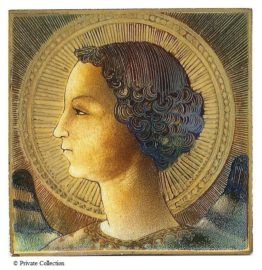 A small tile bearing the image of the Archangel Gabriel is, according to some art experts in Rome, the oldest surviving work made by Leonardo da Vinci. He did it when he was 17 and it is the only one bearing his signature. Except for a sketch with a view of the Valdinievole on paper, kept at the Uffizi Museum in Florence and drawn when he was 20, there is nothing else signed.
A small tile bearing the image of the Archangel Gabriel is, according to some art experts in Rome, the oldest surviving work made by Leonardo da Vinci. He did it when he was 17 and it is the only one bearing his signature. Except for a sketch with a view of the Valdinievole on paper, kept at the Uffizi Museum in Florence and drawn when he was 20, there is nothing else signed.
Prof. Ernesto Solari thinks that it a self-portrait of Leonardo and, we have to admit that, its likeliness with the David by Verrocchio are indeed impressive. Leonardo shows here a strong oriental look, with thin eyebrows, low cheeks. These are traits which not necessarily derives from his mother being an Oriental slave – as we have argued – but that was a typical mark of the old Sienese school of painting, which was often used for the representation of sacred images. This is clearly visible in Giotto and Simone Martini
Solari’s claim was dismissed out of hand by Leonardo’s expert Martin Kemp, who told to the Guardian newspaper: “The chance of its being by Leonardo is less than zero. The silly season for Leonardo never closes.” But Kempt, like the late Carlo Pedretti, is very strong on documents but has little eyes for art. Both of them did several mistakes authenticating works which were then proven false.
The tile was presented encased in a glass at a press conference in Rome by Prof Ernesto Solari, who has written extensively on the Renaissance genius, there was also Ivana Bonfantin, a handwriting expert, who is sure that the small handwriting scratched under the glaze were drawn by Leonardo’s heavenly hand.
There are signatures et inscriptions all over it including a sequence of numbers and Leonardo’s signature back to front in his mirror-writing with a coded message translated as: “I, Leonardo da Vinci, born in 1452, represented myself as the Archangel Gabriel in 1471.”
According to Prof. Solari extensive scientific dating tests, including thermoluminescence (TL), bear out the 15th century date of the tile, which is owned by an aristocratic family in Ravello.
He further adds that the tile was fired in the pottery kiln of Leonardo’s paternal grandparents. This we think unlikely considering that they could not fire pieces of such beauty, but only very basic ones.
Should we conclude that it is a XIX copy? I am afraid we cannot do it. How to explain the positive TL test? Since it shows a firing around the date indicated, then, it should really be a Leonardo da Vinci work. Being a glazed tile it is not possible to use an old tile, then glaze it and have it refired, otherwise the TL test will not respond.
Our conclusioni is that if the TL test is really positive then it can only be a Leonardo Da Vinci.
